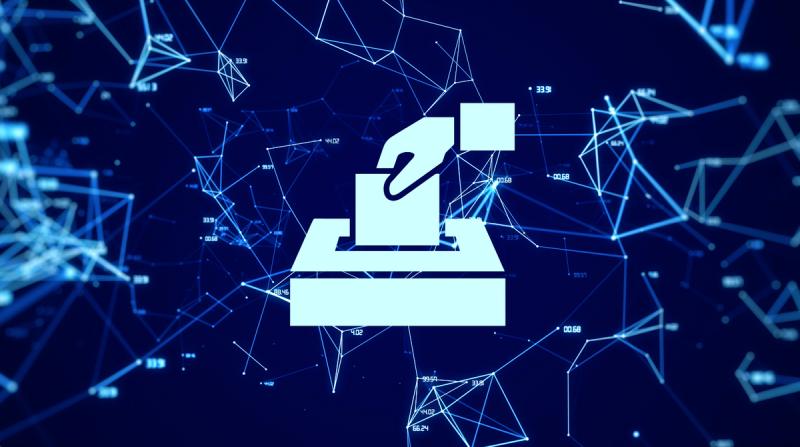The Blockchain Voting System: Why is Democracy Threatened?

The Blockchain Voting System: Why is Democracy Threatened?
Several security experts caution that blockchain-based voting is vulnerable to assaults regardless of the underlying infrastructure as demand for online voting utilizing the blockchain voting system grows domestically and internationally.
Table of Contents
Definition of Blockchain Technology
Blockchain technology is a framework for storing public transactional records, sometimes known as “blocks,” across many databases or “chains.”
It is a network with peer-to-peer nodes connecting it.
This type of storage is refer to as a “digital ledger” in plain English.
The owner’s digital signature approves every transaction in this ledger. Its owner protects the transaction from being tampered with and authenticates it. As a result, you will discover that the data included in the digital ledger is always entirely secure.
The digital ledger and a Google spreadsheet distribute among several computers connect by a network can be compare.
The transactional records, in this instance, are kept in accordance with actual purchases.
The good news is that while anyone may view the data, it cannot be alter.
1. The Working Mechanism of Blockchain Technology
You may have noticed that several businesses have developed blockchain business applications in recent years. But how exactly does blockchain technology operate? Blockchain’s technological achievements, which are still in their infancy, have the potential to change the future.
Three key technologies combine to form Blockchain:
- keys for cryptography
- a peer-to-peer system using a shared ledger
- a technique for computing that stores network activity and records.
Functioning Mechanism of Blockchain Technology
The private and public keys are two essential keys in cryptography. These keys are necessary for two parties to conduct successful transactions.
These two keys are unique to each person who uses them to create a reference to a secure digital identity. Blockchain technology is fundamentally based on this protected identity. A “digital signature” is the term use to describe this identity in the bitcoin industry. It is employed for transaction authorization and control.
Peer-to-peer networking is paired with digital signatures. To use the digital signature to agree on transactions and other issues, this network’s many participants operate as authorities.
After they approve a trade, a mathematical verification is used to certify it. The end outcome is a successful, secure transaction between the two network-connected parties.
In conclusion, cryptographic keys are used by Blockchain users to conduct various digital operations across the peer-to-peer network.
Numerous businesses have recently shown interest in creating Blockchain business applications.
2. What is the Blockchain Voting System?
A blockchain voting system uses applications of blockchain technology to enable online voting.
This peer-to-peer blockchain voting technology uses encryption and write-once techniques to append numerous electronic ledgers and communicate registration data and ballots secretly and securely across the internet.
As Blockchain has particular characteristics like a unique biometric protection system, facial recognition, and thumbprints, many people think it is incredibly secure.
Security experts consider the Blockchain voting method to be a threat to democracy, nevertheless. They claim that situations involving online voting could lead to server penetration attacks, malware on client devices, denial-of-service attacks, and other disruptions.
3. A Real-World Example of the Blockchain Voting System’s Flaws
A compelling narrative about a University of Michigan student who attempt to hack Virginia’s Voatz blockchain-based voting system was featured in a news piece in October last year.
According to the article, the FBI is investigating the situation and determining whether these assertions are factual.
Voatz, a blockchain-based smartphone voting app, was design to gather votes from West Virginians who live abroad, are in the military, or are incapacitate.
The West Virginia Secretary of State, Andrew “Mac” Warner, claimed to have discovered specific activities planned to gain unauthorized access to the voting application’s mainframe functional module.
It should be emphasize that the Voatz app uses various levels for verifying a person’s identification, including face recognition, thumbnails, and voter-verified ballots.
What were the Findings?
Warner immediately made it clear that all aspects of digital security were considered. Simply put, no votes had been altered, seen, or harmed in any other way.
This is where the blockchain voting system’s flaws started to show up.
So let’s focus on some of the arguments demonstrating how the Blockchain voting system poses a threat to democracy.
4.The Blockchain Voting System Is a Danger to Democracy for These 3 Main Reasons.
The blockchain voting system doesn’t have security options.
Using Voatz as an example, even though it is a very novel idea, MIT researchers identified several flaws in the design.
They discovered that it was simpler for hackers to change, halt, or reveal a user’s voting behavior. Additionally, it was discover that Voatz used a third-party vendor to locate and confirm voters. This led to significant privacy problems.
A government can primarily use a Blockchain voting system to give transparency rather than security. It is just being utilize as an auditing technique for experimental government voting. The Blockchain voting system was not initially develop for this purpose.
Blockchain-based voting can manipulate voter behavior.
When voting takes place outside of a protected booth, it opens up opportunities for vote-buying and voter intimidation. Demonstrating that the vote was cast for the correct candidate is crucial to vote-buying transactions.
Vote-buying will become more straightforward with Blockchain-based voting. However, it is still possible with traditional voting systems, which is difficult but not impossible. Social scientists’ role in this situation has taken on a vital significance.
They must first create incentive structures that deter vote-buying and intimidation.
For instance, before the polls close in Estonia, any voter can alter their vote many times. As a result, it is more challenging and expensive for a vote buyer to confirm that a vote seller cast their ballot for the candidate they said they would.
Also read: Metaverse Virtual Worlds!
Also read: Cyber Forensics




